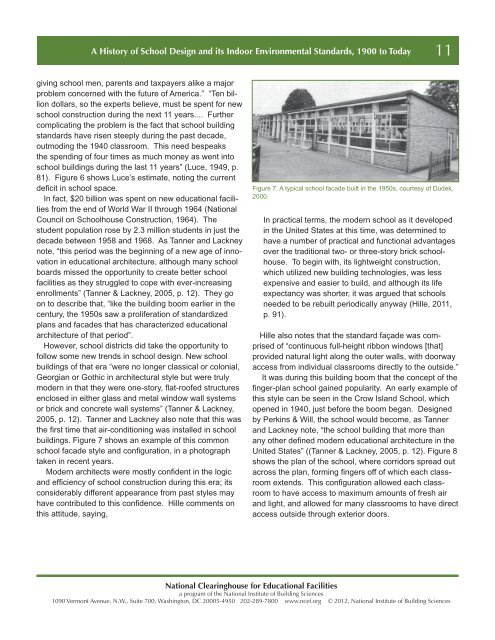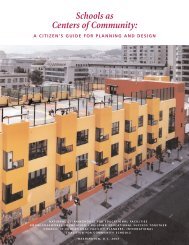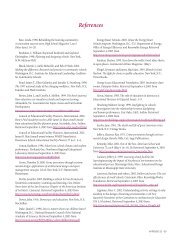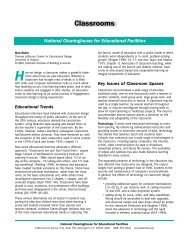A History of School Design and its Indoor - National Clearinghouse ...
A History of School Design and its Indoor - National Clearinghouse ...
A History of School Design and its Indoor - National Clearinghouse ...
You also want an ePaper? Increase the reach of your titles
YUMPU automatically turns print PDFs into web optimized ePapers that Google loves.
A <strong>History</strong> <strong>of</strong> <strong>School</strong> <strong>Design</strong> <strong>and</strong> <strong>its</strong> <strong>Indoor</strong> Environmental St<strong>and</strong>ards, 1900 to Today<br />
giving school men, parents <strong>and</strong> taxpayers alike a major<br />
problem concerned with the future <strong>of</strong> America.” “Ten billion<br />
dollars, so the experts believe, must be spent for new<br />
school construction during the next 11 years.... Further<br />
complicating the problem is the fact that school building<br />
st<strong>and</strong>ards have risen steeply during the past decade,<br />
outmoding the 1940 classroom. This need bespeaks<br />
the spending <strong>of</strong> four times as much money as went into<br />
school buildings during the last 11 years” (Luce, 1949, p.<br />
81). Figure 6 shows Luce’s estimate, noting the current<br />
defi cit in school space.<br />
In fact, $20 billion was spent on new educational facilities<br />
from the end <strong>of</strong> World War II through 1964 (<strong>National</strong><br />
Council on <strong>School</strong>house Construction, 1964). The<br />
student population rose by 2.3 million students in just the<br />
decade between 1958 <strong>and</strong> 1968. As Tanner <strong>and</strong> Lackney<br />
note, “this period was the beginning <strong>of</strong> a new age <strong>of</strong> innovation<br />
in educational architecture, although many school<br />
boards missed the opportunity to create better school<br />
facilities as they struggled to cope with ever-increasing<br />
enrollments” (Tanner & Lackney, 2005, p. 12). They go<br />
on to describe that, “like the building boom earlier in the<br />
century, the 1950s saw a proliferation <strong>of</strong> st<strong>and</strong>ardized<br />
plans <strong>and</strong> facades that has characterized educational<br />
architecture <strong>of</strong> that period”.<br />
However, school districts did take the opportunity to<br />
follow some new trends in school design. New school<br />
buildings <strong>of</strong> that era “were no longer classical or colonial,<br />
Georgian or Gothic in architectural style but were truly<br />
modern in that they were one-story, fl at-ro<strong>of</strong>ed structures<br />
enclosed in either glass <strong>and</strong> metal window wall systems<br />
or brick <strong>and</strong> concrete wall systems” (Tanner & Lackney,<br />
2005, p. 12). Tanner <strong>and</strong> Lackney also note that this was<br />
the fi rst time that air-conditioning was installed in school<br />
buildings. Figure 7 shows an example <strong>of</strong> this common<br />
school facade style <strong>and</strong> confi guration, in a photograph<br />
taken in recent years.<br />
Modern architects were mostly confi dent in the logic<br />
<strong>and</strong> effi ciency <strong>of</strong> school construction during this era; <strong>its</strong><br />
considerably different appearance from past styles may<br />
have contributed to this confi dence. Hille comments on<br />
this attitude, saying,<br />
<strong>National</strong> <strong>Clearinghouse</strong> for Educational Facilities<br />
a program <strong>of</strong> the <strong>National</strong> Institute <strong>of</strong> Building Sciences<br />
1090 Vermont Avenue, N.W., Suite 700, Washington, DC 20005-4950 202-289-7800 www.ncef.org © 2012, <strong>National</strong> Institute <strong>of</strong> Building Sciences<br />
11<br />
Figure 7. A typical school facade built in the 1950s, courtesy <strong>of</strong> Dudek,<br />
2000.<br />
In practical terms, the modern school as it developed<br />
in the United States at this time, was determined to<br />
have a number <strong>of</strong> practical <strong>and</strong> functional advantages<br />
over the traditional two- or three-story brick schoolhouse.<br />
To begin with, <strong>its</strong> lightweight construction,<br />
which utilized new building technologies, was less<br />
expensive <strong>and</strong> easier to build, <strong>and</strong> although <strong>its</strong> life<br />
expectancy was shorter, it was argued that schools<br />
needed to be rebuilt periodically anyway (Hille, 2011,<br />
p. 91).<br />
Hille also notes that the st<strong>and</strong>ard façade was comprised<br />
<strong>of</strong> “continuous full-height ribbon windows [that]<br />
provided natural light along the outer walls, with doorway<br />
access from individual classrooms directly to the outside.”<br />
It was during this building boom that the concept <strong>of</strong> the<br />
fi nger-plan school gained popularity. An early example <strong>of</strong><br />
this style can be seen in the Crow Isl<strong>and</strong> <strong>School</strong>, which<br />
opened in 1940, just before the boom began. <strong>Design</strong>ed<br />
by Perkins & Will, the school would become, as Tanner<br />
<strong>and</strong> Lackney note, “the school building that more than<br />
any other defi ned modern educational architecture in the<br />
United States” ((Tanner & Lackney, 2005, p. 12). Figure 8<br />
shows the plan <strong>of</strong> the school, where corridors spread out<br />
across the plan, forming fi ngers <strong>of</strong>f <strong>of</strong> which each classroom<br />
extends. This confi guration allowed each classroom<br />
to have access to maximum amounts <strong>of</strong> fresh air<br />
<strong>and</strong> light, <strong>and</strong> allowed for many classrooms to have direct<br />
access outside through exterior doors.










